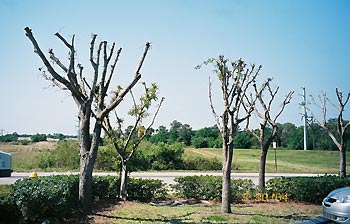Home > Pruning shade trees > Restoration pruning > Restoring topped trees
Restoring topped trees

Recently topped trees will develop water sprouts in the months following pruning. These often develop at or near the tips of the broken branches. Sprouting is an attempt by the weakened tree to replace the photosynthesis-generating foliage that was removed suddenly. Trees damaged in cold weather can respond similarly.
Sprouting requires expenditure of stored starch (energy) inside the living wood of the tree and further weakens the tree. However, sprouting is essential for recovery because it replaces energy (starch and other storage compounds) reserves. Sprouts should be allowed to grow for several years without pruning so energy reserves can be replaced! Once sprouts have grown for one to several years they begin competing for the same space and should be reduced in number.
Topped stems and branches (see photo) can decay causing a weakness, and the sprouts that grow from the cuts are poorly attached at least for a period of several years.
Treatment: The goal in restoring these trees is to prune so that eventually there is only one main leader at the location of each topping cut (See: illustration of how to do this). Save several sprouts spaced apart (12 inches apart if possible) from each other that appear to be capable of growing into strong limbs. The ones you save should have plenty of lateral branches and perhaps a slight swelling or collar where it meets the broken branch.
Remove one-third of the other sprouts and shorten one-third of the other sprouts so the saved sprouts can develop lateral branches and good taper. This prevents all the sprouts from growing too long and becoming weak and makes room for growth and development of lateral branches from the new leader. Some topped stems and branches can be removed altogether if they are too close to others and will not contribute to developing good structure.
A few years later, some of the sprouts left intact or shortened in the first restoration pruning might require shortening to allow the remaining ones to develop further. This process might have to be repeated for about ten years until remaining branches are spaced along the scaffold limbs.
As sprouts slow down their growth rate and begin acting like branches, you might consider shortening some limbs that were originally topped with a reduction cut. This would only be recommended if the limb was becoming too long, or began to droop, or was getting in the way. Do not reduce the scaffold limb too soon after the tree was over pruned because this could cause further stress and more sprouting.

